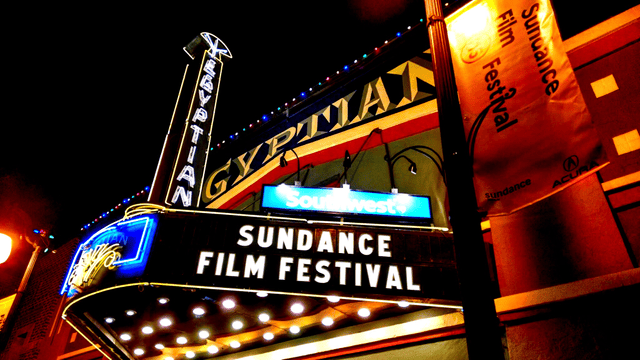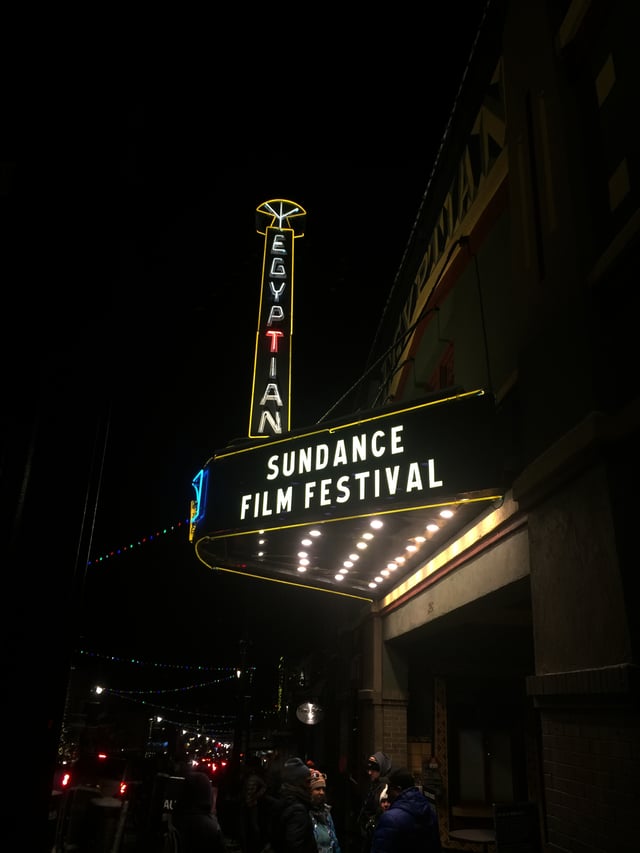Sundance Film Festival

Sundance Film Festival

| Sundance Film Festival | |
|---|---|
| Location | Park City, Salt Lake City, Provo, Utah, United States Sundance Resort, Utah, United States |
| Founded | 1978 |
| Founded by | John Earle, Sterling Van Wagenen |
| Hosted by | Sundance Institute |
| Language | English |
| Website | sundance.org/festival [37] |

Mary G. Steiner Egyptian Theatre is one of the festival's oldest and most recognizable venues
The Sundance Film Festival (formerly Utah/US Film Festival, then US Film and Video Festival) is an annual film festival organized by the Sundance Institute. It takes place each January in Park City, Utah, Salt Lake City, and at the Sundance Resort, and is the largest independent film festival in the United States. It includes competitive categories, includes documentary and dramatic films, both feature length and short films, in which awards are given, as well as out-of-competition categories for showcasing new films.
The 2019 Sundance Film Festival began January 24 and ran through February 3. The 2020 event will take place from January 23 to February 2, 2020.
| Sundance Film Festival | |
|---|---|
| Location | Park City, Salt Lake City, Provo, Utah, United States Sundance Resort, Utah, United States |
| Founded | 1978 |
| Founded by | John Earle, Sterling Van Wagenen |
| Hosted by | Sundance Institute |
| Language | English |
| Website | sundance.org/festival [37] |
Description
Sundance is the largest independent film festival in the US, with more than 46,660 attending in 2016.[1] It is held in January in Park City, Salt Lake City and the Sundance Resort (a ski resort near Provo, Utah) and acts as a showcase for new work from American and international independent filmmakers.[2]
The festival consists of competitive sections for American and international dramatic and documentary films, both feature films and short films, and a group of out-of-competition sections, including NEXT, New Frontier, Spotlight, Midnight, Premieres, and Documentary Premieres.
History
1978: Utah/US Film Festival
Sundance began in Salt Lake City in August 1978 as the Utah/US Film Festival, in an effort to attract more filmmakers to Utah.[3] It was founded by Sterling Van Wagenen (then head of Wildwood,[4] Robert Redford's company), John Earle (serving on the Utah Film Commission at the time). The 1978 festival featured films such as Deliverance, A Streetcar Named Desire, Midnight Cowboy, Mean Streets, and The Sweet Smell of Success.[5] With chairman Robert Redford, and the help of Utah Governor Scott M. Matheson, the goal of the festival was to showcase strictly American-made films, highlight the potential of independent film, and to increase visibility for filmmaking in Utah. At the time, the main focus of the event was to conduct a competition for independent American films, present a series of retrospective films and filmmaker panel discussions, and to celebrate the Frank Capra Award. The festival also highlighted the work of regional filmmakers who worked outside the Hollywood system.
The jury of the 1978 festival was headed by Gary Allison, and included Verna Fields, Linwood G. Dunn, Katharine Ross, Charles E. Sellier Jr., Mark Rydell, and Anthea Sylbert.
In 1979, Sterling Van Wagenen left to head up the first-year pilot program of what was to become the Sundance Institute, and James W. (Jim) Ure took over briefly as executive director, followed by Cirina Hampton Catania as executive director. More than 60 films were screened at the festival that year, and panels featured many well-known Hollywood filmmakers. Also that year, the first Frank Capra Award went to Jimmy Stewart. The festival also made a profit for the first time. In 1980, Catania left the festival to pursue a production career in Hollywood.
Several factors helped propel the growth of Utah/US Film Festival. First was the involvement of actor and Utah resident Robert Redford, who became the festival's inaugural chairman. By having Redford's name associated with the festival, it received great attention. Secondly, the country was hungry for more venues that would celebrate American-made films as the only other festival doing so at the time was the USA Film Festival in Dallas (est. 1971). Response in Hollywood was unprecedented, as major studios did all they could to contribute their resources.
1981: US Film and Video Festival
In 1981, the festival moved to Park City, Utah, and changed the dates from September to January. The move from late summer to midwinter was done by the executive director Susan Barrell with the cooperation of Hollywood director Sydney Pollack, who suggested that running a film festival in a ski resort during winter would draw more attention from Hollywood. It was called the US Film and Video Festival.
1984: Sundance
In 1984, the now well-established Sundance Institute, headed by Sterling Van Wagenen, took over management of the US Film Festival. Gary Beer and Van Wagenen spearheaded production of the inaugural US Film Festival presented by Sundance Institute (1985), which included Program Director Tony Safford and Administrative Director Jenny Walz Selby. The branding and marketing transition from the US Film Festival to the Sundance Film Festival was managed under the direction of Colleen Allen, Allen Advertising Inc., by appointment of Robert Redford. In 1991, the festival was officially renamed the Sundance Film Festival, after Redford's character the Sundance Kid from the film Butch Cassidy and the Sundance Kid.[6]
Spin-offs in other locations
Sundance London (2012– )
UK-based publisher C21 Media first revealed in October 2010 that Robert Redford was planning to bring the Sundance Film Festival to London,[7] and in March the following year, Redford officially announced that Sundance London would be held at The O2, in London from 26–29 April 2012; the first time it has traveled outside the US.[8]
In a press statement, Redford said, "We are excited to partner with AEG Europe to bring a particular slice of American culture to life in the inspired setting of The O2, and in this city of such rich cultural history. [...] It is our mutual goal to bring to the UK, the very best in current American independent cinema, to introduce the artists responsible for it, and in essence help build a picture of our country that is broadly reflective of the diversity of voices not always seen in our cultural exports."[8]
Sundance Hong Kong
Inaugurated in 2014, Sundance Film Festival: Hong Kong has taken place in 2016, 2017 and 2018. The next event is scheduled to run from 19 September to 1 October 2019. It is held at The Metroplex in Kowloon Bay each year.[18]
Sundance at BAM
From 2006 through 2008, Sundance Institute collaborated with the Brooklyn Academy of Music (BAM) on a special series of film screenings, performances, panel discussions, and special events bringing the institute's activities and the festival's programming to New York City.[19]
Notability
Many notable independent filmmakers received their big break at Sundance, including Kevin Smith, Robert Rodriguez, Quentin Tarantino, Todd Field, David O. Russell, Steve James, Paul Thomas Anderson, Steven Soderbergh, Darren Aronofsky, James Wan, Edward Burns, and Jim Jarmusch. The festival is also responsible for bringing wider attention to such films as Saw, Garden State, Super Troopers, The Blair Witch Project, Spanking the Monkey, Reservoir Dogs, Primer, In the Bedroom, Better Luck Tomorrow, Little Miss Sunshine, Donnie Darko, El Mariachi, Moon, Clerks, Thank You for Smoking, Sex, Lies, and Videotape, The Brothers McMullen, (500) Days of Summer, Napoleon Dynamite, Whiplash, Boyhood, and Get Out.
Three Seasons was the first in festival history to ever receive both the Grand Jury Award and Audience Award, in 1999. Later films that won both awards are: God Grew Tired of Us in 2006 (documentary category), Quinceañera in 2006 (dramatic category), Precious in 2009, Fruitvale (later retitled Fruitvale Station) in 2013, Whiplash in 2014, Me and Earl and the Dying Girl in 2015, and The Birth of a Nation in 2016.
At the 2016 Sundance Film Festival, three films went on to garner eight Oscar nominations.[20] Manchester by the Sea took the lead in Sundance-supported films with six Oscar nominations, including Best Picture.[21] The next year, about 40 films were acquired by distributors, among them including Amazon, Netflix, Lionsgate, and Universal.[22]
Growth of the festival
The festival has changed over the decades from a low-profile venue for small-budget, independent creators from outside the Hollywood system to a media extravaganza for Hollywood celebrity actors, paparazzi, and luxury lounges set up by companies not affiliated with Sundance. Festival organizers have tried curbing these activities in recent years, beginning in 2007 with their ongoing Focus On Film campaign.
The 2009 film Official Rejection documented the experience of small filmmakers trying to get into various festivals in the late 2000s, including Sundance. The film contained several arguments that Sundance had become dominated by large studios and sponsoring corporations. A contrast was made between the 1990s, in which non-famous filmmakers with tiny budget films could get distribution deals from studios like Miramax Films or New Line Cinema, (like Kevin Smith's Clerks), and the 2000s, when major stars with multimillion-dollar films (like The Butterfly Effect with Ashton Kutcher) dominated the festival. Kevin Smith doubted that Clerks, if made in the late 2000s, would be accepted to Sundance.[23]
Numerous small festivals sprung up around Sundance in the Park City area, including Slamdance, Nodance, Slumdance, It-dance, X-Dance, Lapdance, Tromadance, The Park City Film Music Festival, etc., though all except Slamdance are no longer held.[24]
Included in the Sundance changes made in 2010, a new programming category titled "NEXT" (often denoted simply by the characters "<=>", which mean "less is more") was introduced to showcase innovative films that are able to transcend the confines of an independent budget. Another recent addition was the Sundance Film Festival USA program, in which eight of the festival's films are shown in eight different theaters around the United States.[25]
See also
2003 Sundance Film Festival, 2004 Sundance Film Festival, etc.
List of Sundance Film Festival award winners
List of Sundance Film Festival selections
Sundance Channel